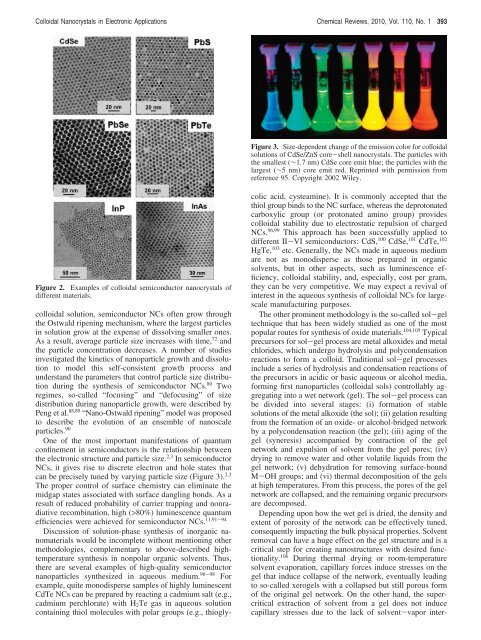Prospects of Colloidal Nanocrystals for Electronic - Computer Science
Prospects of Colloidal Nanocrystals for Electronic - Computer Science
Prospects of Colloidal Nanocrystals for Electronic - Computer Science
Create successful ePaper yourself
Turn your PDF publications into a flip-book with our unique Google optimized e-Paper software.
<strong>Colloidal</strong> <strong>Nanocrystals</strong> in <strong>Electronic</strong> Applications Chemical Reviews, 2010, Vol. 110, No. 1 393<br />
Figure 2. Examples <strong>of</strong> colloidal semiconductor nanocrystals <strong>of</strong><br />
different materials.<br />
colloidal solution, semiconductor NCs <strong>of</strong>ten grow through<br />
the Ostwald ripening mechanism, where the largest particles<br />
in solution grow at the expense <strong>of</strong> dissolving smaller ones.<br />
As a result, average particle size increases with time, 72 and<br />
the particle concentration decreases. A number <strong>of</strong> studies<br />
investigated the kinetics <strong>of</strong> nanoparticle growth and dissolution<br />
to model this self-consistent growth process and<br />
understand the parameters that control particle size distribution<br />
during the synthesis <strong>of</strong> semiconductor NCs. 80 Two<br />
regimes, so-called “focusing” and “defocusing” <strong>of</strong> size<br />
distribution during nanoparticle growth, were described by<br />
Peng et al. 88,89 “Nano-Ostwald ripening” model was proposed<br />
to describe the evolution <strong>of</strong> an ensemble <strong>of</strong> nanoscale<br />
particles. 90<br />
One <strong>of</strong> the most important manifestations <strong>of</strong> quantum<br />
confinement in semiconductors is the relationship between<br />
the electronic structure and particle size. 2,3 In semiconductor<br />
NCs, it gives rise to discrete electron and hole states that<br />
can be precisely tuned by varying particle size (Figure 3). 2,3<br />
The proper control <strong>of</strong> surface chemistry can eliminate the<br />
midgap states associated with surface dangling bonds. As a<br />
result <strong>of</strong> reduced probability <strong>of</strong> carrier trapping and nonradiative<br />
recombination, high (>80%) luminescence quantum<br />
efficiencies were achieved <strong>for</strong> semiconductor NCs. 11,91-94<br />
Discussion <strong>of</strong> solution-phase synthesis <strong>of</strong> inorganic nanomaterials<br />
would be incomplete without mentioning other<br />
methodologies, complementary to above-described hightemperature<br />
synthesis in nonpolar organic solvents. Thus,<br />
there are several examples <strong>of</strong> high-quality semiconductor<br />
nanoparticles synthesized in aqueous medium. 96-98 For<br />
example, quite monodisperse samples <strong>of</strong> highly luminescent<br />
CdTe NCs can be prepared by reacting a cadmium salt (e.g.,<br />
cadmium perchlorate) with H2Te gas in aqueous solution<br />
containing thiol molecules with polar groups (e.g., thiogly-<br />
Figure 3. Size-dependent change <strong>of</strong> the emission color <strong>for</strong> colloidal<br />
solutions <strong>of</strong> CdSe/ZnS core-shell nanocrystals. The particles with<br />
the smallest (∼1.7 nm) CdSe core emit blue; the particles with the<br />
largest (∼5 nm) core emit red. Reprinted with permission from<br />
reference 95. Copyright 2002 Wiley.<br />
colic acid, cysteamine). It is commonly accepted that the<br />
thiol group binds to the NC surface, whereas the deprotonated<br />
carboxylic group (or protonated amino group) provides<br />
colloidal stability due to electrostatic repulsion <strong>of</strong> charged<br />
NCs. 96,99 This approach has been successfully applied to<br />
different II-VI semiconductors: CdS, 100 CdSe, 101 CdTe, 102<br />
HgTe, 103 etc. Generally, the NCs made in aqueous medium<br />
are not as monodisperse as those prepared in organic<br />
solvents, but in other aspects, such as luminescence efficiency,<br />
colloidal stability, and, especially, cost per gram,<br />
they can be very competitive. We may expect a revival <strong>of</strong><br />
interest in the aqueous synthesis <strong>of</strong> colloidal NCs <strong>for</strong> largescale<br />
manufacturing purposes.<br />
The other prominent methodology is the so-called sol-gel<br />
technique that has been widely studied as one <strong>of</strong> the most<br />
popular routes <strong>for</strong> synthesis <strong>of</strong> oxide materials. 104,105 Typical<br />
precursors <strong>for</strong> sol-gel process are metal alkoxides and metal<br />
chlorides, which undergo hydrolysis and polycondensation<br />
reactions to <strong>for</strong>m a colloid. Traditional sol-gel processes<br />
include a series <strong>of</strong> hydrolysis and condensation reactions <strong>of</strong><br />
the precursors in acidic or basic aqueous or alcohol media,<br />
<strong>for</strong>ming first nanoparticles (colloidal sols) controllably aggregating<br />
into a wet network (gel). The sol-gel process can<br />
be divided into several stages: (i) <strong>for</strong>mation <strong>of</strong> stable<br />
solutions <strong>of</strong> the metal alkoxide (the sol); (ii) gelation resulting<br />
from the <strong>for</strong>mation <strong>of</strong> an oxide- or alcohol-bridged network<br />
by a polycondensation reaction (the gel); (iii) aging <strong>of</strong> the<br />
gel (syneresis) accompanied by contraction <strong>of</strong> the gel<br />
network and expulsion <strong>of</strong> solvent from the gel pores; (iv)<br />
drying to remove water and other volatile liquids from the<br />
gel network; (v) dehydration <strong>for</strong> removing surface-bound<br />
M-OH groups; and (vi) thermal decomposition <strong>of</strong> the gels<br />
at high temperatures. From this process, the pores <strong>of</strong> the gel<br />
network are collapsed, and the remaining organic precursors<br />
are decomposed.<br />
Depending upon how the wet gel is dried, the density and<br />
extent <strong>of</strong> porosity <strong>of</strong> the network can be effectively tuned,<br />
consequently impacting the bulk physical properties. Solvent<br />
removal can have a huge effect on the gel structure and is a<br />
critical step <strong>for</strong> creating nanostructures with desired functionality.<br />
106 During thermal drying or room-temperature<br />
solvent evaporation, capillary <strong>for</strong>ces induce stresses on the<br />
gel that induce collapse <strong>of</strong> the network, eventually leading<br />
to so-called xerogels with a collapsed but still porous <strong>for</strong>m<br />
<strong>of</strong> the original gel network. On the other hand, the supercritical<br />
extraction <strong>of</strong> solvent from a gel does not induce<br />
capillary stresses due to the lack <strong>of</strong> solvent-vapor inter-
















